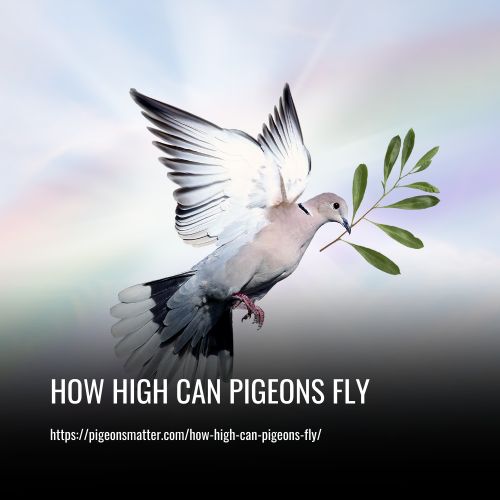Pigeons have been known to fly at impressive speeds, reaching an impressive 90 miles per hour while averaging between 50 to 60 miles per hour. Their exceptional flying has been recorded at altitudes of 6000 feet or more, which is attributed to their flight physics and unique wingspan.
The altitude a pigeon can fly is influenced by several factors, including air pressure and the various breeds of pigeons. Pigeons with unique body structures tend to fly higher than their counterparts typically seen in cities. However, their flight at such heights prompts their high-altitude behaviors, including slow, controlled flight, and their unique methods of breathing to counter low oxygen levels.

Introduction to Pigeons and Their Flying Abilities
Pigeons are a remarkable species known for their exceptional flying abilities. They have been around for centuries and have been revered for their remarkable navigational skills and endurance. There are various types of pigeons, including homing pigeons and racing pigeons, each with unique qualities that make them excel in their fields. Pigeons have been used throughout history for messaging purposes and as professional racing birds, making them a vital part of human societies for centuries.
One of the fascinating aspects of pigeons is their incredible speed and distance capabilities. Pigeons can reach speeds of up to 50 miles per hour and fly distances of more than 700 miles in a single flight. Height is also an essential factor in their flight capabilities. While the altitude a pigeon can fly varies depending on the breed and atmospheric conditions, they can soar to heights of over 6,000 feet!
But how do these birds navigate through their surroundings? Pigeons use a combination of celestial cues, such as the position of the sun and stars, and their sense of smell to navigate. Additionally, environmental factors such as air pressure, wind conditions, and the time of day, can affect their ability to fly at high altitudes.
Factors that Affect Pigeon’s Flying Height
Pigeons are known for their impressive flight capabilities, including reaching great heights while in flight. However, several factors contribute to how high a pigeon can fly.
Wind currents are one of the most critical factors that affect a pigeon’s flying height. Pigeons tend to fly at higher altitudes on hot days, as the air currents are much stronger. This can help them conserve energy during flight, as they can effectively use the wind to lift themselves higher. On the other hand, cold and rainy conditions can disrupt wind currents, making it difficult for pigeons to fly at high altitudes.
Air pressure is another environmental factor that plays a significant role in a pigeon’s ability to fly at high altitudes. Atmospheric pressure changes with altitude, and high-pressure systems can be more difficult for pigeons to navigate through. Changes in air pressure can also affect how much lift a pigeon can get from wind currents, making it more challenging for them to fly at high elevations.
Birds of prey are another factor that can contribute to how high pigeons will fly. Pigeons are prey to various bird species, including hawks and falcons. When danger is nearby, pigeons will take flight and move to higher altitudes to avoid predators. While it may seem counterintuitive, flying at high altitudes can be an effective way for pigeons to avoid being captured by predators.
Energy conservation is also essential for pigeons while in flight, especially when flying long distances. When flying at high altitudes, pigeons can conserve energy by taking advantage of strong wind currents and using less energy to flap their wings. This conservation is critical for their survival, the longer the distance pigeons fly, the more they need to conserve energy.
Domestication and breeding can also affect a pigeon’s ability to fly at high altitudes. Pigeons that have been bred for specific characteristics, such as fancy breeds, may not be as aerodynamic as other breeds that are better suited for flight. Additionally, domestication can make some pigeons less fit for flight than their wild counterparts, making it more difficult for them to fly at higher altitudes.
Behavioral and Environmental Factors that Affect a Pigeon’s Flying Hei
Pigeons are known for their impressive flying abilities, but their height and speed can be affected by various behavioral and environmental factors. Understanding these factors is crucial for pigeon fanciers and racing enthusiasts who want to optimize their birds’ performance.
Temperature is a crucial factor affecting a pigeon’s flying height. Pigeons tend to fly higher on hot days when air currents are stronger which can help them conserve energy during flight. Conversely, cold temperatures and rain can disrupt wind currents, making it harder for pigeons to fly at higher altitudes, leading to slower speeds.
Air pressure is another environmental factor that affects a pigeon’s ability to fly. Atmospheric pressure changes with altitude, and high-pressure systems can be challenging for pigeons. High-pressure areas can affect how much lift a pigeon can get from wind currents, which can make it more challenging for them to fly at high elevations. Low-pressure areas, on the other hand, make flying easier, which can increase the bird’s speed and height.
The wind is also a crucial environmental factor affecting pigeon flight. Strong winds can help pigeons fly at higher altitudes and conserve energy. However, too much wind can be dangerous for pigeons, leading to turbulence and making it more difficult for them to fly at high elevations.
Obstructions like buildings, trees, and mountains can also affect a pigeon’s flight. Flying at higher altitudes can help pigeons avoid obstructions and conserve energy, but they may have to navigate through obstacles, which can slow them down and reduce their speed.
Pigeon size and age also play a role in their ability to fly at high altitudes. Younger pigeons tend to be less experienced and may not be able to fly as high as older birds. Smaller pigeons may also have a harder time flying at higher altitudes compared to larger birds, as their body mass and size could be a limiting factor.
Interesting Facts and Myths about Pigeons and Their Flying Abilities
Interesting Facts and Myths about Pigeons and Their Flying Abilities:
Pigeons have a rich history and are known for their impressive flying abilities. However, there are also many misconceptions and myths surrounding these birds. Here are some interesting facts and myths related to pigeons and their flying abilities.
1. Myth: Pigeons are dirty and carry diseases.
Fact: While feral pigeons may carry some diseases, domesticated pigeons and show pigeons are generally clean and healthy birds.
2. Myth: All pigeons are the same.
Fact: There are over 300 breeds of pigeons, each with its unique characteristics and attributes.
3. Myth: Pigeons have poor eyesight.
Fact: Homing pigeons have excellent eyesight and can see ultraviolet light, which helps them navigate.
4. Myth: Pigeons can’t fly high.
Fact: Pigeons can fly at altitudes up to 6,000 feet and can reach speeds of up to 92 miles per hour.
5. Myth: Pigeons are stupid.
Fact: Pigeons are intelligent birds and have been used throughout history for a variety of purposes, including as messengers in wars and as racing birds.
6. Myth: Pigeons can’t navigate.
Fact: Homing pigeons have a unique ability to navigate, even over long distances, using a combination of skills like detecting magnetic fields, sensing the sun’s position, and mapping the earth’s features.
7. Myth: Pigeons can’t fly long distances without stopping.
Fact: Homing pigeons can fly up to 700 miles without stopping for rest or food.
8. Myth: Pigeons are pests.
Fact: While some feral pigeons can be considered pests, many people keep pigeons as pets or show birds and consider them to be valuable animals.
Early History of Pigeon Flying
Pigeons have been used by humans for various purposes throughout history, and their ability to fly has been a valuable asset in many civilizations. One of the most prominent uses of pigeons in history was as messengers. In ancient times, the Greeks, Persians, and Romans used pigeons to deliver important messages across long distances. These birds were highly valued for their speed and reliability.
During times of war, pigeons played an essential role in communication. For example, during World War I and II, homing pigeons proved to be vital in delivering messages from the front lines to headquarters. Pigeons were also used during the Korean and Vietnam wars. Their ability to fly even in adverse conditions and maintain a sense of direction allowed them to deliver crucial information.
As human societies evolved, so did the communication networks, and with this came the formation of postal services. The early postal systems, especially in Europe and Asia, relied on pigeons to deliver messages quickly and reliably over long distances. The 12th century marks the beginning of the use of pigeons as postal carriers. It was around this time that some towns in Belgium, France, Spain, and Italy started using the birds to carry messages to neighboring towns.
How High Can a Domestic/Homing Pigeon Fly?
Domestic or homing pigeon, also known as Columba livia domestica, is a breed that is widely used for racing and as messenger birds due to their strong homing instincts. But how high can they fly?
On average, domestic pigeons can fly up to 6000 feet in the air. However, some homing pigeons have been recorded to fly up to heights of 10,000 feet or more. Their impressive flying height is attributed to their unique physical characteristics, which allow them to soar high without getting tired.
Physical traits such as a large wingspan, streamlined body, and strong muscles make it possible for domestic pigeons to fly great distances and at high altitudes. These traits are essential for their homing instincts which enable them to navigate with precision using the sun’s position, the Earth’s magnetic fields, and other external factors.
Air pressure and resistance can also impact the flying heights of domestic pigeons. Pigeons are diurnal birds and tend to fly higher during the daytime when air density and pressure are more favorable. In contrast, pigeons tend to fly lower during the night when air density and visibility are lower.
Pigeon: The Highest-Flying Bird in the World
Pigeons are well known for their unique flying abilities, making them the highest-flying bird in the world. These remarkable creatures can fly to altitudes of up to 6,000 feet and reach speeds exceeding 90mph. But what is it about pigeons that accounts for their extraordinary flying skills?
Pigeons possess several physical traits that make them strong and talented flyers. Their large wingspan, streamlined bodies, and strong muscles work in concert to provide the necessary lift and maneuverability during flight. Furthermore, their exceptional vision allows them to perceive their surroundings with great clarity, making it easier for them to navigate through the air.
Homing and racing pigeons are two popular types of pigeons known for their extraordinary flying abilities. Both share the same traits that enable them to reach impressive heights in the sky. Homing pigeons are named owing to their homing instincts, which allow them to return home from long distances. This unique ability is what makes them ideal for delivering messages and has also been used extensively in military applications.
How High Do Pigeons Fly? – Bond with your bird
Bonding with your bird is crucial to understanding its flying habits, including altitude capabilities. Experienced keepers and fanciers have noted that spending time with their birds has led to a deeper comprehension of pigeon behavior and needs, thus strengthening the bond between bird and owner. Regularly taking your pigeon for flights and walks, offering engaging toys and activities, and socializing with other birds are all essential to better grasp your pigeon’s unique flight patterns, such as altitude and duration.
Training and playtime are practical suggestions to build your bond and help you identify your bird’s preferred toys and activities, further understanding their personality. Socializing your pigeon with other birds is a crucial aspect of their well-being and growth as social creatures.
FAQs
Pigeons are capable of flying up to 6000 feet in altitude, although the optimal flying height is around 3000 to 6000 feet.
Some factors that can affect the flying height of a pigeon include air pressure, air resistance, source of food, weather conditions, and time of day.
Pigeons can fly for several hours without stopping, covering distances of over 600 miles in a single day. The exact duration depends on various factors, including the pigeon’s condition, the distance to be covered, and the wind conditions.
Racing pigeons are bred for their endurance and can cover distances of up to 2000 kilometers in a single race.
On average, pigeons can fly at a speed of 50 to 60 miles per hour, although some racing pigeons can reach speeds of up to 90 miles per hour.
The average lifespan of a domesticated pigeon is around 5 years, while feral pigeons have an average lifespan of 3 to 4 years.
Pigeons have been used for centuries for various purposes, including racing, messaging, and military purposes. In ancient times, pigeons were also used for their meat and eggs.
Yes, there are different types of pigeons, including racing pigeons and homing pigeons, which are bred for their ability to fly longer and higher than other pigeon breeds.
Pigeons can fly for long periods because they have a special type of feathers called flight feathers. These feathers are different from the feathers on the rest of the bird’s body. They are longer and have a different shape. The flight feathers on the wings are also arranged specially so that they can produce lift.
Conclusion:
Pigeons are impressive flyers that can reach heights of up to 6000 feet. Their ability to fly for several hours without stopping and cover long distances has made them valuable for various purposes throughout history, from messaging to racing.
Knowing the factors that affect the flying height of pigeons, such as air pressure and weather conditions, can help pigeon fanciers and keepers understand how best to care for their pigeons and optimize their flying abilities.

